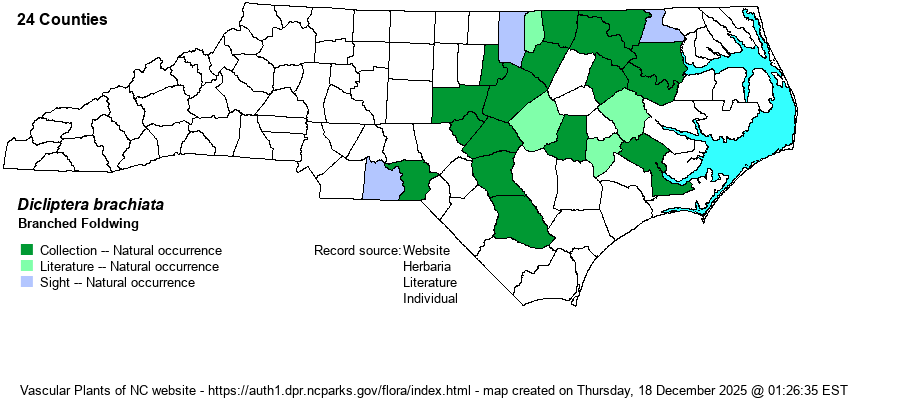| Author | (Pursh) Sprengel | |
| Distribution | Present across the central and western Coastal Plain, and into the eastern Piedmont; however, limited to brownwater river floodplains. Ranges west to Granville, Chatham, and Anson counties; and east to Hertford, Bertie, Martin, and Craven counties.
This is a Southern species, most numerous in the Southern Plains states. It ranges east to VA, NC, and central FL; however, it is absent from montane areas. | |
| Abundance | Uncommon to locally common along brownwater river floodplains -- Meherrin, Roanoke (especially), Tar, Neuse, Cape Fear (especially), and Pee Dee. Essentially absent otherwise. The NCNHP's State Rank of S2? is woefully incorrect, as it is quite common along parts of the Roanoke River and Cape Fear River; a State Rank of S3S4 is much more appropriate. | |
| Habitat | This is strictly a plant of rich alluvial soil, deposited during flooding events along brownwater rivers. It grows on natural levee forests and in bottomland forests, especially favoring light gaps. | |
| Phenology | Bloom from August to October, and fruits shortly after flowering. | |
| Identification | This is a familiar plant to biologists if they work brownwater river floodplains, such as along the Roanoke River. However, most biologists are probably unfamiliar with it. It is a rather robust herb, growing mostly to 2 feet tall, rarely to 3 feet tall, with several branches (most of which are ascending and stiff/straight). The scattered leaves are opposite, with very long petioles, often 2 inches long or more. The leaf blade is ovate, 3-4 inches long and about 2 inches wide, with a nearly truncate base and tapering to a point at the tip; the margins are entire or undulating, though not serrate. The flowers are in axillary clusters, some sessile but others on pedicels. The flowers are unique in NC -- two "lips" (technically the flowers are in 5 parts), bright rose to rose-pink in color and a spread nearly 3/4-inch from top to bottom, each spreading (with a top lip and a bottom lip), with stamens and pistil long extending from the throat. This species can seem a bit weedy, in that it can grow in very dense stands in openings in the floodplains, so that it is impossible to count the number of plants. The plants can be identified vegetatively by the opposite leaves on very long stalks and an ovate blade with a nearly squared-off base. When in bloom, the bright rose-pink colors of the very odd flowers should catch the eye. | |
| Taxonomic Comments | None
| |
| Other Common Name(s) | Dicliptera, Branched Dicliptera, Wild Mudwort | |
| State Rank | S2? [S3S4] | |
| Global Rank | G5 | |
| State Status | | |
| US Status | | |
| USACE-agcp | FACW link |
| USACE-emp | FACW link |

